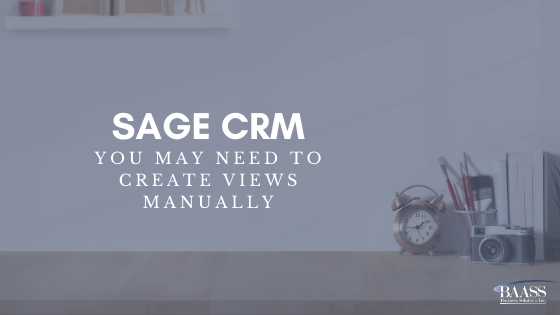Although there are numerous reasons to switch from outsourced payroll to an in-house payroll system, the biggest factor is probably cost – handling payroll in-house will involve huge savings.
Read More >In-House versus Outsourced Payroll
Have you outgrown your Accounting Software System?
As your firm grows or your competitive environment changes you will probably need to replace your accounting software system at some point. The key objective is launching this critical project at the right time. If you wait too long, the pressure may be so high that you rush the purchase decision and that can lead to a disastrous outcome. At the same time if you do nothing, you may miss an opportunity to compete more effectively in your market or run your business more efficiently. What should you do and when should you start the process?
Working Smart with Intacct
Intacct puts many powerful tools at your disposal; two in particular stand out as powerhouse customization utilities – Smart Rules and Smart Events. Today we’ll be looking at Smart Rules and what they can do for your organization.
Read More >Working “Smart” with Intacct (Part 1)
Intacct puts many powerful tools at your disposal; two in particular stand out as powerhouse customization utilities – Smart Rules and Smart Events. Today we’ll be looking at Smart Rules and what they can do for your organization.
Read More >Sage Inventory Advisor ordering constraints
Permission for Access to the Sage Customer Portal
Sage is making changes to work with BAASS Business Solutions in assisting you when you need us!
Sage has recently invested in new technology that allows us, your Sage Partner, to work more closely together in supporting you and your Sage 300 system.
Keep your eyes open in your inbox for an email from Sage, this email will instruct you in making a change to your Sage profile that allows BAASS Business Solutions to stay informed with any issues you log with Sage directly.
A Boot Camp For Better Networking - Sage Software Leadership Academy
By Alan Salmon
The Bottom Line - August 2007
Sage CRM - You may need to create views manually
Why does it appear?
The can be several reasons why this message appears and it usually comes when there has been a change in the configuration of the system. This maybe as a result of an upgrade, or if the SQL password for the "sa" user has been changed, and the same change has not been affected in CRM.
Subscribe Here!
POSTS BY SOLUTION
- CRM (54)
- ERP (53)
- BI (43)
- Tips & Tricks (37)
- Cloud (33)
- HRIS (26)
- Baass Connect (25)
- Payroll (16)
- Error Message (15)
- Manufacturing (13)
- WMS (13)
- Business Intelligence (12)
- Sage CRM (11)
- Sage 300 ERP (10)
- Sage Tips (10)
- BAASS News (8)
- Baass Business Solutions (8)
- Inventory (8)
- Sage 300 (8)
- Cloud Computing (7)
- Intacct (7)
- Sage ERP (7)
- Cloud ERP (6)
- Service Management (6)
- Development (5)
- Fixed assets (5)
- Sage Intacct (5)
- Security (5)
- Work From Home (5)
- data management (5)
- inventory management (5)
- remote working (5)
- AI (4)
- Supply Chain Software (4)
- business forecasting (4)
- cloud solution (4)
- project management (4)
- Cloud Security (3)
- Customer Relationship Management (3)
- ERP system (3)
- Sage Payroll (3)
- financial data (3)
- AP Automation (2)
- Accounting Software (2)
- Automation software (2)
- BI Tools (2)
- Budgeting (2)
- Business General (2)
- CRM system (2)
- Canadian Payroll (2)
- Cloud Accounting (2)
- Cloud Financial Management (2)
- Cloud Hosting (2)
- Compliance & Risk Management (2)
- Crystal Reporting (2)
- Digital Transformation (2)
- Excel (2)
- Fixed Fee Pricing (2)
- Forecasting (2)
- Legislation (2)
- Mining (2)
- Productivity (2)
- Reporting (2)
- Sage FAS (2)
- Sage HRMS (2)
- Sage HRMS Payroll (2)
- Sage X3 (2)
- Senior Living (2)
- Success Story (2)
- tips (2)
- womenintech (2)
- AR Automation (1)
- Accounts Payable (1)
- Accpac (1)
- Avalara (1)
- BAASS Trace (1)
- BI Software (1)
- Barcoding (1)
- Benefits of Cloud Computing (1)
- Best Practices (1)
- CRA (1)
- Canada Pension Plan (1)
- Canadian Business (1)
- Canadian Dental Care Pension Plan (1)
- Cloud Services (1)
- Cloud Software (1)
- Construction (1)
- Credit Card Payments (1)
- Credit Card Processing (1)
- Distribution (1)
- Document Management (1)
- EDI (1)
- ERP Cloud (1)
- ERP Consultant (1)
- ERP Software Failure (1)
- ERP solution (1)
- Economic (1)
- Evaluate Accounting Software (1)
- Evaluate your software (1)
- Evaluating Accounting Software (1)
- FAS (1)
- Finanacial Year Closing (1)
- Financial Management (1)
- Financial Solutions (1)
- Food and Beverage (1)
- Function of Warehouse Management Systems (1)
- Global Business (1)
- Inventory Control (1)
- Multi Entity (1)
- NFP (1)
- Nonprofits (1)
- Operational and Financial Information Systems (1)
- Order constraints (1)
- Outgrown QuickBooks (1)
- PST in BC (1)
- Plus Computer Solutions (1)
- RRSP (1)
- Sage (1)
- Sage 300 Payroll (1)
- Sage BI (1)
- Sage Business Partner (1)
- Sage Enterprise Intelligence (1)
- Sage Intelligence (1)
- Sage Inventory Advisor (1)
- Sage Software (1)
- Senior Living Facility (1)
- T4 (1)
- T4/T4A Boxes (1)
- Tailored Solutions (1)
- The Cloud (1)
- Year End Close (1)
- Year end Payroll Checklist (1)
- accounting management software (1)
- accounting software system (1)
- cloud based solution (1)
- conference (1)
- data (1)
- data backup (1)
- efficiency (1)
- employee self service (1)
- myths (1)
- planning (1)
- solution (1)
- staff scheduling (1)
- technology (1)
- training (1)




